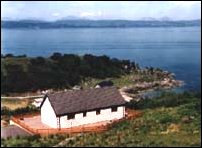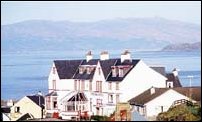

Algemene informatie
 Mallaig is a fishing village
with a population of about one thousand, situated at the most westerly end
of the peninsula of North Morar and is now the largest centre of population
in West Lochaber. The name is probably derived from the Gaelic Mol or Mal,
meaning 'shingly' and the Norse vik, meaning 'bay'
Mallaig is a fishing village
with a population of about one thousand, situated at the most westerly end
of the peninsula of North Morar and is now the largest centre of population
in West Lochaber. The name is probably derived from the Gaelic Mol or Mal,
meaning 'shingly' and the Norse vik, meaning 'bay'
THE FOUNDING OF MALLAIG: The village of Mallaig itself is a relatively recent
creation, dating from the 1840s, when Lord Lovat, owner of North Morar Estate,
divided up the farm of Mallaigvaig into seventeen parcels of land and encouraged
his tenants to move to the western part of the peninsula and turn to fishing
as a way of life.
We cannot be sure of precisely what motives lay behind this or how willing
the local population were to move from the more fertile but certainly overpopulated
settlements beside Loch Morar and Loch Nevis onto the rough and windy plots
of land at Mallaig, but what is certain is that between 1841 and 1851 the population
of Mallaig rose from 24 to 134 and it had become the largest settlement in
the district.
THE MOVE TO FISHING: In the census of 1851 the heads of many of these households
already described themselves as "crofter-fishermen" and by 1861 fishing
was obviously becoming more and more important, as no fewer than 18 "fishers" were
recorded there. However, fishing in the 19th century was a hazardous business.
Everything revolved around the shoals of herring, which could not be depended
upon to turn up where they were expected. The local boats were too small to
follow the fish further afield, so if the herring did not appear in Loch Hourn
or Loch Nevis in July, hard times would follow.
In November 1881 there was a combination of gale and high tide which carried
away a number of boats and destroyed some of the houses built near to the sea.
This must have affected Mallaig and Mallaigvaig seriously because the population
fell from 170 to 133 and the number of houses from 31 to 28 by 1891. Fortunately
Lovat provided replacement boats and nets at his own expense and in 1882 the
fishing was so successful that 'two steamers ran daily with fish to Oban, which
raised the price per cran to 38 shillings, the highest on record in Loch Nevis'.
The opening of the Oban railway in 1880 and its impact on fish prices must
have registered strongly with Lovat and his tenants. If a railway to Oban could
do this then imagine what the effect would be of a terminus in Mallaig itself!
In 1883 the local priest commented that none of the Morar people took any grievances
to the Napier Commission, which had been set up by the government of the time
to look into the plight of the people of the Highlands. 'The Proprietor seeing
this was pleased, and to assist their efforts and advance their prosperity
in the fishing industry, he thought proper to build for them a Storehouse at
Mallaig Pier, at his own expense, and fill it with salt and barrels. The first
night of November thereafter, the bay was full of herring and some boats caught
as high as 24 and 30 crans. This success elated the fishermen to such an extent
that numbers of them have provided themselves with larger and better boats
and a new set of nets'. In 1885, 1886 and 1887 the herring failed to appear
in great numbers and the fishing was bad, making fishermen and crofters unable
to pay their rents. Although both proprietor and people had decided that their
future lay with fishing its immediate progress was limited. It is understandable
that Lovat wanted to bring the railway to Mallaig - it was a way of ensuring
the future of the community, the fishing industry and his own investment.
THE 20th CENTURY BEGINS: The railway extension to Mallaig finally opened in
1901 and rapidly transformed the local economy and way of life. Even before
construction of the line began, people had moved there in anticipation of the
increase in trade. With the opening of the line others arrived to set up shops
and businesses and to work on the railway and for the steamer company. Steamer
passengers travelled along the line from Glasgow before transferring to vessels
bound for Skye, Stornoway and the Outer Hebrides. Fishermen, curers and coopers
moved in from the Aberdeenshire and Berwickshire coasts, and with the coming
of the herring season, were supplemented by teams of herring girls, following
the herring around the coasts of Britain and Ireland.
The new harbour was far closer to the rich fishing grounds west of Barra than
either of the other railheads at Oban and Kyle of Lochalsh and fishing vessels
were quick to exploit the possibility of getting their catches to market faster.
A concrete breakwater had been built as part of the railway infrastructure
and fish was loaded directly into railway wagons on the quay ready to be taken
south. By sheer good fortune the opening of the line coincided with the great
movement from sail to steam in the fishing fleet. Steam drifters were not as
dependent on the weather as were sailing vessels and, important for Mallaig
and its railway, they needed to be supplied with coal, which could be easily
brought north along the new railway.
Before long Mallaig harbour was being used by far more vessels than had been
expected. Extensions to the wharf began almost immediately, with the construction
of a fish platform on the landward side of the railway pier. Further improvements
were made in 1908 and again in 1915, creating a timber landing stage bridging
the space between the railway pier and Lovat's masonry pier. On the rocky and
exposed point on the seaward side of the railway pier were built several kippering
sheds and about thirty wooden huts, used as accommodation for migrant fishworkers.
So basic did the accommodation appear, even in the less-than-affluent early
years of the 20th century, that this part of Mallaig acquired the name "Chinatown".
THE VILLAGE EXPANDS: In the years following the First World War new houses
were built at Clanranald Terrace and Marine Place but flat land for further
building was already becoming scarce. During the 1920's the track leading round
East Bay towards Mallaigvaig was widened to form a road and more houses built
there, including three blocks of flats. Other houses, including the doctor's
house and the manse were constructed beside the road to Glasnacardoch, where
the old school had been replaced by a new building in Mallaig itself, where
the primary school now stands.
THE FIRST CAR FERRY: In 1932 local boatbuilder John Henderson and marine engineer
Angus Macintyre constructed a flat bottomed vessel capable of carrying two
cars and began transporting vehicles across the five miles which separate Mallaig
from Armadale on Skye. At that time cars were few in number, and even fewer
were drivers intrepid enough to tackle the switchback route from Fort William.
However, the 'Road to the Isles', as the ferry was named, was successful enough
for Henderson and Macintyre to double its capacity by lengthening the vessel
and to form 'Road to the Isles Ferries Limited' in 1935.On the outbreak of
war in 1939 tourist traffic ceased and the 'Road to the Isles' stopped operating.
It was eventually beached in the Morar estuary and could be seen there for
many years after, slowly disintegrating.
During the Second World War the whole area west of Fort William became a Special
Protected Area. Through Mallaig passed supplies and agents bound for SOE training
centres in Knoydart and along Loch Nevis.
YEARS OF PLENTY: In the years following the war new fishing methods brought
hitherto unimaginable catches of fish and in the 1960s Mallaig could realistically
claim to be the busiest herring port in Europe. During the herring season the
harbour would be a hive of activity, as vessels scrambled to unload their catches
into lorries from as far afield as Denmark and Holland. More fish left by sea,
bought by fleets of Norwegian 'Klondikers'.
However, by the mid 1970s, Mallaig's prosperity was crumbling. The railway
was repeatedly threatened with closure and new ferries introduced to cater
for the growing use of the motor car began to use more direct routes - Kyle
of Lochalsh became the main route to Skye, ferries for Stornoway began leaving
from Ullapool and services to Barra and South Uist moved to Oban. Fish stocks
were suffering from years of overfishing and a four year ban on herring fishing
was imposed. The Mallaig fleet was forced to turn to alternative catches, such
as mackerel and whitefish.
Tourism was becoming more and more important and in 1984 Scotrail introduced
a steam-hauled service on the Fort William - Mallaig section of the West Highland
Line.The experiment was a success and the service continues to this day, operated
by a private company and known as the Jacobite Steam Train.
MALLAIG TODAY: After the lean years of the 1980s Mallaig is modestly prosperous
again, landing large quantities of shellfish, especially prawns. The village
now has facilities that were sadly lacking for many years. A new primary school
has replaced the 1920s building, and a new High School serves the area from
Knoydart to Acharacle, ending at last the system under which children commuted
each week to school in Fort William. The Fishermens' Mission and the swimming
pool provide meeting places and recreation as well as opportunities for spiritual
and physical development. Rollon-rolloff car ferries were introduced in 1984,
increasing and accelerating services to Skye and also enabling the return of
services to South Uist and Barra. The new outer harbour completed in 1998 permits
larger vessels to use the port and has freed up space in the inner harbour
for visiting pleasure craft.
As the 21st century begins, Mallaig is poised to take advantage of its position
as the most westerly port on mainland Britain and is difficult to recognise
as the hastily developed harbour of almost a century ago.